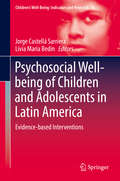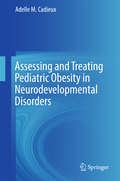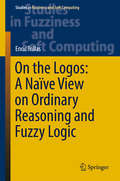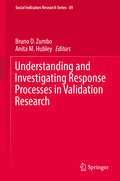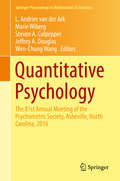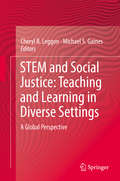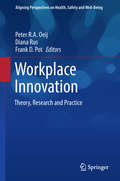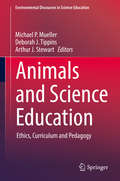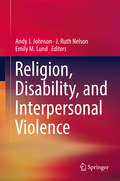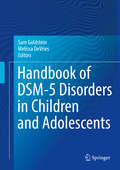- Table View
- List View
Psychosocial Well-being of Children and Adolescents in Latin America: Evidence-based Interventions (Children’s Well-Being: Indicators and Research #16)
by Jorge Castellá Sarriera Lívia Maria BedinThis book discusses child well-being, with children and adolescents as key informants, from a Latin American perspective. It explores theoretical and empirical issues related to well-being and associated aspects, in order to understand the well-being of this population. Topics analyzed in this volume address for instance environment and community, rights, leisure time, technologies, interpersonal relationships and spirituality and their implications for changes in the well-being in children and adolescents. Especially relevant for scholars and professionals in the social and health sciences, as well as policy makers, seeking to promote child well-being, regardless of the area in which they operate.
Identity Flexibility During Adulthood: Perspectives in Adult Development
by Jan D. SinnottThis volume seeks to explore the idea of identity as a flexible center of events around which aspects of the self and events in the outside world are organized. Historically, in much of the literature, identity was conceptualized as a somewhat fixed, unchanging construct. Scholars now have a greater awareness of more nuanced theories about identity and there is a greater willingness to accept that identity is not fixed, concrete, and permanent, but rather evolving and fluid. Although this volume discusses a wide variety of aspects of identity as it flexibly changes during adulthood in the face of numerous experiences, it is really addressing one key question. How adaptive and fluid is identity and how can we know ourselves as both continuing and changing? Exploring these ideas raises the importance of future research on adult identity. With a firm grounding in the historical and theoretical background of identity research, this volume begins by defining identity and the psychological “self” as a center around which the person’s behaviors and self-concepts revolve. The following chapters gather the wisdom of many writers who all accepted the challenge of talking about creating a flexible adult self and identity during adulthood. They come at this challenging question from many different perspectives using different tools. Some survey existing literature and theory, then summarize prior work in a meaningful way. Some discuss their own research; some reflect on personal experiences that have demanded a flexible identity. Also included in the coverage are discussions of methodology and validity issues for studies and scales of identity. With its dual focus on research and applied fields ranging across social and personality psychology, industrial/occupational psychology, cross-cultural psychology, mental health, existential issues, relationships, and demographic categories, Identity Flexibility During Adulthood: Perspectives on Adult Development is a fascinating and complex resource for psychologists, sociologists, anthropologists, gerontologists, and all those interested in our changing identities.
Psychological, Emotional, Social and Cognitive Aspects of Implantable Cardiac Devices
by Riccardo Proietti Gian Mauro Manzoni Giada Pietrabissa Gianluca CastelnuovoElectrical therapy of the heart has rapidly evolved over recent years with the development of the cardiac implantable defibrillator and the application of the cardiac resynchronization therapy to improve performance of the congestive failed heart. There is an impressive amount of literature produced to assess the efficacy and effectiveness of the electrical therapy. New technology is continuously introduced into the market for the treatment of electrical heart disease with optimized performance and implemented design, with approximately 600,000 new pacemakers implanted each year. Attention of the electrophysiology community has mainly focused on the biomedical aspects of electrical therapy, but the psychological, emotional, social and cognitive aspects of the implantable devices has been largely overlooked. Health-related quality of life (QoL) and, to a lesser extent, psychological disorders, i.e. anxiety and depression, have rarely been assessed as outcomes in clinical trials, and results are pointing towards the impact of the implantable devices on QoL and mental health not being direct but moderated and mediated by several biomedical as well as psychosocial variables. Furthermore, the cognitive effects of the implantable devices have rarely been assessed in empirical studies, although cognitive impairment is largely associated with the heart disorders that require implantation of an electrical device and cognitive benefits are strongly expected from the therapy. The aim of this book is to collect, appraise and condense the results of all empirical studies that have investigated, even marginally, the relationships between the implantable devices and any psychological, emotional, social and cognitive dimension. This book is a cornerstone for all involved in device utilization (physicians, nurses, technicians, industry representatives) that need to understand this topic.
Kant’s Ethics and the Same-Sex Marriage Debate - An Introduction
by Christopher ArroyoThis book defends the thesis that Kant’s normative ethics and his practical ethics of sex and marriage can be valuable resources for people engaged in the contemporary debate over same-sex marriage. It does so by first developing a reading of Kant’s normative ethics that explains the way in which Kant’s notions of human moral imperfection unsocial sociability inform his ethical thinking. The book then offers a systematic treatment of Kant’s views of sex and marriage, arguing that Kant’s views are more defensible than some of his critics have made them out to be. Drawing on Kant’s account of marriage and his conception of moral friendship, the book argues that Kant’s ethics can be used to develop a defense of same-sex marriage.
Assessing and Treating Pediatric Obesity in Neurodevelopmental Disorders
by Adelle M. CadieuxThis book reviews strategies for assessing and treating pediatric obesity in children with neurodevelopmental disorders (ND). It synthesizes empirical findings and clinical strategies to offer the latest knowledge in key areas, including risk factors, physical activity, nutrition, treatment planning, goal-setting, and engagement with patients. A four-stage treatment model presents clinical guidance in triaging treatment and tailoring interventions to children’s changing medical, behavioral, emotional, and cognitive needs. The book complements current pediatric ND literature by presenting clear guidelines for integrating treatment for obesity into existing treatment of these young patients. Topics featured in this book include: The effect of neurodevelopmental disorders on the assessment of obesity in children.The impact of developmental delays on physical activities and health behaviors.Strategies for promoting weight management goals in pediatric ND.Suggestions on how to engage and support families and caregivers.The role of prevention in weight management within pediatric ND. Assessing and Treating Pediatric Obesity in Neurodevelopmental Disorders is a must-have resource for clinicians, scientist-practitioners, and related professionals as well as researchers, professors, and graduate students in clinical child and school psychology, public health, social work, pediatrics, occupational therapy, and nutrition.
Coma and Disorders of Consciousness
by Caroline Schnakers Steven LaureysThis revised and expanded second edition discusses the assessment and treatment of patients recovering from coma and disorders of consciousness. Besides diagnostic, prognostic and ethical issues, this book describes well-established techniques and procedures, and also techniques under development. New chapters include consciousness theories, issues relating to long-term care, and neuromodulation treatments. Coma and Disorders of Consciousness, Second Edition is a comprehensive review of the field for clinicians and researchers, regardless of whether they are already familiar with the difficult but exciting field of disorders of consciousness.
On the Logos: A Naïve View on Ordinary Reasoning and Fuzzy Logic (Studies in Fuzziness and Soft Computing #354)
by Enric TrillasThis book offers an inspiring and naïve view on language and reasoning. It presents a new approach to ordinary reasoning that follows the author’s former work on fuzzy logic. Starting from a pragmatic scientific view on meaning as a quantity, and the common sense reasoning from a primitive notion of inference, which is shared by both laypeople and experts, the book shows how this can evolve, through the addition of more and more suppositions, into various formal and specialized modes of precise, imprecise, and approximate reasoning. The logos are intended here as a synonym for rationality, which is usually shown by the processes of questioning, guessing, telling, and computing. Written in a discursive style and without too many technicalities, the book presents a number of reflections on the study of reasoning, together with a new perspective on fuzzy logic and Zadeh’s “computing with words” grounded in both language and reasoning. It also highlights some mathematical developments supporting this view. Lastly, it addresses a series of questions aimed at fostering new discussions and future research into this topic. All in all, this book represents an inspiring read for professors and researchers in computer science, and fuzzy logic in particular, as well as for psychologists, linguists and philosophers.
Derived Embodiment in Abstract Language
by Theresa SchilhabHow does knowledge of phenomena and events we have no direct experiences of emerge? Having a brain that learns from being in the world, how can we conceive of prehistoric dinosaurs, Atlantis, unicorns or even ‘desire’? This book is about how abstract knowledge becomes anchored in direct experiences through well-formed conversations.Within the framework of evolutionary biology and through the lens of contemporary studies in cognitive science, the neurosciences, sociology and anthropology, this book traces topics such as our inborn sensitivity to the environment, bottom-up and top-down processes in knowledge formation and the importance of language when we learn to categorise the world. A major objective of this monograph is to identify the key determinants of the specific interactivity mechanisms that control the cognitive processes while we are linguistically immersed. The emphasis is on real-life interactions in conversations. While the concrete word-object paradigm depends relatively more on direct experiences, the successful acquisition of abstract knowledge depends on the emphatic skills of the interlocutor. He or she must remain sensitive to the level and quality of the imagination of the child while making mental tableaus that are believed to elicit images to which the child associates the concept. Derived embodiment in abstract thought is a landmark synthesis that operationalizes contemporary neuroscience studies of acquisition of knowledge in the real life conversational context. The result is an exciting biology-based contribution to theories of knowledge acquisition and thinking in sociology, cognitive robotics, anthropology and not at least, pedagogy.
The Factors Effecting Student Achievement: Meta-Analysis of Empirical Studies
by Engin KaradağThis book focuses on the effect of psychological, social and demographic variables on student achievement and summarizes the current research findings in the field. It addresses the need for inclusive and interpretive studies in the field in order to interpret student achievement literature and suggests new pathways for further studies. Appropriately, a meta-analysis approach is used by the contributors to show the big picture to the researchers by analyzing and combining the findings from different independent studies. In particular, the authors compile various studies examining the relationship between student achievement and 21 psychological, social and demographic variables separately. The philosophy behind this book is to direct future research and practices rather than addressing the limits of current studies.
Understanding and Investigating Response Processes in Validation Research (Social Indicators Research Series #69)
by Bruno D. Zumbo Anita M. HubleyThis volume addresses an urgent need across multiple disciplines to broaden our understanding and use of response processes evidence of test validity. It builds on the themes and findings of the volume Validity and Validation in Social, Behavioral, and Health Sciences (Zumbo & Chan, 2014), with a focus on measurement validity evidence based on response processes. Approximately 1000 studies are published each year examining the validity of inferences made from tests and measures in the social, behavioural, and health sciences. The widely accepted Standards for Educational and Psychological Testing (1999, 2014) present five sources of evidence for validity: content-related, response processes, internal structure, relationships with other variables, and consequences of testing. Many studies focus on internal structure and relationships with other variables sources of evidence, which have a long history in validation research, known methodologies, and numerous exemplars in the literature. Far less is understood by test users and researchers conducting validation work about how to think about and apply new and emerging sources of validity evidence. This groundbreaking volume is the first to present conceptual models of response processes, methodological issues that arise in gathering response processes evidence, as well as applications and exemplars for providing response processes evidence in validation work.
International Perspectives on Psychotherapy
by Stefan G. HofmannThis clear-sighted resource critically examines the status of clinical psychology practice across the diverse regions of the world. Dispatches from North and Latin America, Eastern and Central Europe, China, South Korea, Australia, Africa, the Middle East, and elsewhere illustrate in depth the universality of mental distress and disorders, and the intersection of local knowledge and established standards in providing effective care. Pathology and its treatment are viewed in light of cultural values, belief systems, ethics, and norms, reflecting the evolution of clinical practice toward personalized care and culturally sensitive intervention. This important information serves a number of immediate and long-term goals, including developing culture-specific diagnoses and treatments, improving professional competencies, and the ongoing exchange of ideas within a global field to benefit all patients worldwide. Coverage compares key areas such as: · Concepts of mental pathology and health. · The sociopolitical aspects of psychology, rooted in the history of the country/region. · Popularly used approaches to intervention. · Types of services and providers. · The state of training and credentialing. · Relationships between clinical psychology and indigenous healing traditions. The audience for Clinical Psychology across the World includes advanced undergraduate and graduate students and trainees/interns in clinical psychology, as well as developers of training programs. It can also serve as a valuable supplementary text for seminars or lectures on clinical psychology.
Learning from Dynamic Visualization: Innovations in Research and Application
by Richard Lowe Rolf PloetznerThis volume tackles issues arising from today’s high reliance on learning from visualizations in general and dynamic visualizations in particular at all levels of education. It reflects recent changes in educational practice through which text no longer occupies its traditionally dominant role as the prime means of presenting to-be-learned information to learners. Specifically, the book targets the dynamic visual components of multimedia educational resources and singles out how they can influence learning in their own right. It aims to help bridge the increasing gap between pervasive adoption of dynamic visualizations in educational practice and our limited understanding of the role that these representations can play in learning.The volume has recruited international leaders in the field to provide diverse perspectives on the dynamic visualizations and learning. It is the first comprehensive book on the topic that brings together contributions from both renowned researchers and expert practitioners. Rather than aiming to present a broad general overview of the field, it focuses on innovative work that is at the cutting edge.As well as further developing and complementing existing approaches, the contributions emphasize fresh ideas that may challenge existing orthodoxies and point towards future directions for the field. They seek to stimulate further new developments in the design and use of dynamic visualizations for learning as well as the rigorous, systematic investigation of their educational effectiveness.
HIV/AIDS in Rural Communities: Research, Education, and Advocacy
by Fayth M. Parks Gregory S. Felzien Sally JueThis wide-ranging volume reviews the experience and treatment of HIV/AIDS in rural America at the clinical, care system, community, and individual levels. Rural HIV-related phenomena are explored within healthcare contexts (physician shortages, treatment disparities) and the social environment (stigma, the opioid epidemic), and contrasted with urban frames of reference. Contributors present latest findings on HIV medications, best practices, and innovative opportunities for improving care and care settings, plus invaluable first-person perspective on the intersectionality of patient subpopulations. These chapters offer both seasoned and training practitioners a thorough grounding in the unique challenges of providing appropriate and effective services in the region. Featured topics include: Case study: Georgia’s rural vs. non-rural populations HIV medications: how they work and why they fail Pediatric/adolescent HIV: legal and ethical issues Our experience: HIV-positive African-American women in the Deep South Learning to age successfully with HIV Bringing important detail to an often-marginalized population, HIV/AIDS in Rural Communities will interest and inspire healthcare practitioners including physicians, nurse practitioners, physician assistants, pharmacists, case managers, psychologists, social workers, counselors, and family therapists, as well as educators, students, persons living with HIV, advocates, community leaders, and policymakers.
Building Peace Through Knowledge: The Israeli-Palestinian Case
by Alean Al-KrenawiThis groundbreaking volume documents a comprehensive peacebuilding initiative in addressing the Israeli-Palestinian conflict and reviews the broad theoretical base underlying these efforts. Theory chapters discuss intrinsic peace-related concepts, including the nature of conflict, elements of individual and group identity, the long-term psychological effects of prolonged political hostilities, and the mechanisms of reconciliation and inclusiveness. Central to the coverage is the ambitious Building Peace through Knowledge Project, a four-year multidisciplinary program featuring a diverse palette of professional and community interventions to reduce the occurrence and trauma of political violence. The author reveals powerful insights connecting knowledge to peacebuilding by analyzing: · The relationships between attitudes and ideology in intergroup conflict. · The psychosocial impact of political violence among Israelis and Palestinians. · The literature on people-to-people interventions (P2Ps) in conflict reduction. · The roles of forgiveness, reconciliation, and fairness in conflict resolution. · The methodology and findings of the Building Peace through Knowledge Project. · The potential of knowledge-based interventions in building sustainable peace in other regions. Practitioners, mental health professionals, and scholars with interests in multicultural mental health, cross-cultural psychology, political violence, and peace education will look to Building Peace through Knowledge as an ideabook, a mission statement, and a road map toward a more stable world.
Quantitative Psychology: The 81st Annual Meeting of the Psychometric Society, Asheville, North Carolina, 2016 (Springer Proceedings in Mathematics & Statistics #196)
by L. Andries van der Ark Marie Wiberg Steven A. Culpepper Jeffrey A. Douglas Wen-Chung WangThis proceedings volume compiles and expands on selected and peer reviewed presentations given at the 81st Annual Meeting of the Psychometric Society (IMPS), organized by the University of North Carolina at Greensboro, and held in Asheville, North Carolina, July 11th to 17th, 2016.IMPS is one of the largest international meetings focusing on quantitative measurement in psychology, education, and the social sciences, both in terms of participants and number of presentations. The meeting built on the Psychometric Society's mission to share quantitative methods relevant to psychology, addressing a diverse set of psychometric topics including item response theory, factor analysis, structural equation modeling, time series analysis, mediation analysis, cognitive diagnostic models, and multi-level models. Selected presenters were invited to revise and expand their contributions and to have them peer reviewed and published in this proceedings volume.Previous volumes to showcase work from the Psychometric Society’s meetings are New Developments in Quantitative Psychology: Presentations from the 77th Annual Psychometric Society Meeting (Springer, 2013), Quantitative Psychology Research: The 78th Annual Meeting of the Psychometric Society (Springer, 2015), Quantitative Psychology Research: The 79th Annual Meeting of the Psychometric Society, Madison, Wisconsin, 2014 (Springer, 2015), and Quantitative Psychology Research: The 80th Annual Meeting of the Psychometric Society, Beijing, 2015 (Springer, 2016).
STEM and Social Justice: A Global Perspective
by Cheryl B. Leggon Michael S. GainesThis volume focuses on selected innovative programs designed to augment the science, engineering, engineering and mathematics (STEM) workforce through increasing and enhancing the participation of under-represented groups. The programs span the STEM career pathway—primary, secondary, and tertiary education—and professional development and socialization—in the United States, South Africa, and New Zealand. Similarities as well as differences between and among programs across nations will be systematically analyzed for lessons learned. The conceptualization for this volume developed over the past several years during various international conferences—starting in Havana, Cuba in 2006, and continuing at meetings in Japan (2014), South Africa (2013 and 2015), and New Zealand (2015).
Workplace Innovation: Theory, Research and Practice (Aligning Perspectives on Health, Safety and Well-Being)
by Peter Oeij Diana Rus Frank D. PotThis book focuses on workplace innovation, which is a key element in ensuring that organizations and the people within them can adapt to and engage in healthy, sustainable change. It features a collection of multi-level, multi-disciplinary contributions that combine theory, research and practical perspectives. In addition, the book presents new perspectives from a number of nations on policies with novel theoretical approaches to workplace innovation, as well as international case studies on the subject. These cases highlight the role of leadership, the relation between workplace innovation and well-being, as well as the do’s and don’ts of workplace innovation implementation. Whether you are an experienced workplace practitioner, manager, a policy-maker, unionist, or a student of workplace innovation, this book contains a range of tips, tools and international case studies to help the reader understand and implement workplace innovation.
Values and Behavior: Taking a Cross Cultural Perspective
by Sonia Roccas Lilach SagivWhat are values? How are they different from attitudes, traits, and specific goals? How do our values influence our behavior, and vice versa? How does our culture and environment impact the relationship between values and behavior? These questions and more are rigorously examined by prominent and emerging scholars in this significant volume Values and Behavior: Taking A Cross Cultural Perspective. Personal values are cognitive representations of abstract, desirable motivational goals that guide the way individuals select actions, evaluate people and events, and explain their actions and evaluations. The unique features of values have implications for their impact on behavior. People are highly satisfied with their values and perceive them as close to their ideal selves. At the same time, however, daily interpersonal interaction reveals that individuals hold different, sometimes opposing, value profiles. These individual differences are even more apparent when individuals from different cultures interact. The collected chapters address the links between values and behavior from a cultural perspective. They review studies conducted in various cultures and discuss culture as a moderator of the relationships between values and behavior. Structurally, part I of the volume discusses what values are and how they should be measure; part II then examines the contents of the relationships between values and behavior in different life-domains, including prosocial behavior, aggression, behavior in organizations and relationships formation. Part III explores some of the moderating mechanisms that relate values to behavior. Taken together, these chapters review and synthesize over twenty years of research on values and behavior, and propose new insights that have important implications for both research and for practice.
Animals and Science Education: Ethics, Curriculum and Pedagogy (Environmental Discourses in Science Education #2)
by Michael P. Mueller Deborah J. Tippins Arthur J. StewartThis book discusses how we can inspire today’s youth to engage in challenging and productive discussions around the past, present and future role of animals in science education. Animals play a large role in the sciences and science education and yet they remain one of the least visible topics in the educational literature. This book is intended to cultivate research topics, conversations, and dispositions for the ethical use of animals in science and education. This book explores the vital role of animals with/in science education, specimens, protected species, and other associated issues with regards to the role of animals in science. Topics explored include ethical, curriculum and pedagogical dimensions, involving invertebrates, engineering solutions that contribute to ecosystems, the experiences of animals under our care, aesthetic and contemplative practices alongside science, school-based ethical dialogue, nature study for promoting inquiry and sustainability, the challenge of whether animals need to be used for science whatsoever, reconceptualizing museum specimens, cultivating socioscientific issues and epistemic practice, cultural integrity and citizen science, the care and nurturance of gender-balanced curriculum choices for science education, and theoretical conversations around cultivating critical thinking skills and ethical dispositions. The diverse authors in this book take on the logic of domination and symbolic violence embodied within the scientific enterprise that has systematically subjugated animals and nature, and emboldened the anthropocentric and exploitative expressions for the future role of animals.At a time when animals are getting excluded from classrooms (too dangerous! too many allergies! too dirty!), this book is an important counterpoint. Interacting with animals helps students develop empathy, learn to care for living things, engage with content. We need more animals in the science curriculum, not less.David Sobel, Senior Faculty, Education Department, Antioch University New England
Neuro-Geriatrics: A Clinical Manual
by Babak Tousi Jeffrey CummingsThis manual takes a multidisciplinary approach to neurological disorders in the elderly. Comprehensive and practical, it includes the most recent diagnostic criteria and immediately accessible visual care paths including the latest pharmacologic and non-pharmacologic interventions. Covering a range of modalities, from the importance and impact of each disease to diagnostic criteria, genetics, laboratory and imaging findings, treatment and care paths, this book focuses on neurological conditions that occur commonly in older persons or which have a striking effect on their lives. The common types of dementias, Parkinson’s disease and related disorders, rapidly progressive diseases, seizure disorders and multiple sclerosis are covered. Issues commonly affecting this population, such as neurobehavioral symptoms and caregiver issues, are discussed. Neuro-Geriatrics: A Clinical Manual is aimed at any physician who treats the elderly with neurological disorders: neurologists, geriatricians and geriatric psychiatrists, both specialists and general practitioners.
Future Directions in Well-Being: Education, Organizations and Policy
by Mathew A White Gavin R. Slemp A. Simon MurrayThis book is a collection of essays advancing the discourse in well-being science, authored by key thought leaders in positive psychology and its variants, including positive education, character education, and positive organizational scholarship. The authors address topics such as the next big ideas in well-being research and practice, potential strategies , as well as current gaps and limitations of the field. This book will be of particular interest for policy makers, educators and practitioners, as well as researchers.
Religion, Disability, and Interpersonal Violence
by Andy J. Johnson J. Ruth Nelson Emily M. LundThis groundbreaking reference offers mental health professionals a rigorous, nuanced guide to working with abuse survivors with disabilities in religious communities. Expert contributors unravel complex intersections of disability, religion, and identity in the context of gender violence (including spotlights on racial, gender, and sexual minorities, Deaf persons, and men), and offer survivor-centered best practices for intervention. Chapters explore how responses from clergy and other religious figures may sometimes prevent survivors from seeking help, and how faith leaders can help to empower survivors. The concepts and research presented here support multiple purposes, from removing barriers to survivor services to working with religious communities to be more inclusive and transparent. Among the topics featured: From barriers to belonging for people with disabilities: Promising pathways toward inclusive ministry.Empowering women with intellectual disabilities to resist abuse in interpersonal relationships.Race, culture, and abuse of persons with disabilities.Ableist shame and disruptive bodies: Survivorship at the intersection of queer, trans, and disabled existence.From the narratives of survivors with disabilities: Strengths and gaps between faith-based communities and domestic violence shelters. Religion, Disability, and Interpersonal Violence brings transformative insights to psychologists, social workers, and mental health professionals across disciplines providing guidance within religious and disabled communities in their clinical practice. It also provides valuable background for researchers seeking to examine the interface between religious culture and the abuse of persons with disabilities.
Understanding the Mathematical Way of Thinking – The Registers of Semiotic Representations
by Raymond DuvalIn this book, Raymond Duval shows how his theory of registers of semiotic representation can be used as a tool to analyze the cognitive processes through which students develop mathematical thinking. To Duval, the analysis of mathematical knowledge is in its essence the analysis of the cognitive synergy between different kinds of semiotic representation registers, because the mathematical way of thinking and working is based on transformations of semiotic representations into others. Based on this assumption, he proposes the use of semiotics to identify and develop the specific cognitive processes required to the acquisition of mathematical knowledge. In this volume he presents a method to do so, addressing the following questions:• How to situate the registers of representation regarding the other semiotic “theories” • Why use a semio-cognitive analysis of the mathematical activity to teach mathematics • How to distinguish the different types of registers • How to organize learning tasks and activities which take into account the registers of representation • How to make an analysis of the students’ production in terms of registersBuilding upon the contributions he first presented in his classic book Sémiosis et pensée humaine, in this volume Duval focuses less on theoretical issues and more on how his theory can be used both as a tool for analysis and a working method to help mathematics teachers apply semiotics to their everyday work. He also dedicates a complete chapter to show how his theory can be applied as a new strategy to teach geometry.“Understanding the Mathematical Way of Thinking – The Registers of Semiotic Representations is an essential work for mathematics educators and mathematics teachers who look for an introduction to Raymond Duval’s cognitive theory of semiotic registers of representation, making it possible for them to see and teach mathematics with fresh eyes.”Professor Tânia M. M. Campos, PHD.
Let History into the Mathematics Classroom (History of Mathematics Education)
by Évelyne Barbin Jean-Paul Guichard Marc Moyon Patrick Guyot Catherine Morice-Singh Frédéric Métin Martine Bühler Dominique Tournès Renaud Chorlay Gérard HamonThis book brings together 10 experiments which introduce historical perspectives into mathematics classrooms for 11 to 18-year-olds. The authors suggest that students should not only read ancient texts, but also should construct, draw and manipulate. The different chapters refer to ancient Greek, Indian, Chinese and Arabic mathematics as well as to contemporary mathematics. Students are introduced to well-known mathematicians—such as Gottfried Leibniz and Leonard Euler—as well as to less famous practitioners and engineers. Always, there is the attempt to associate the experiments with their scientific and cultural contexts. One of the main values of history is to show that the notions and concepts we teach were invented to solve problems. The different chapters of this collection all have, as their starting points, historic problems—mathematical or not. These are problems of exchanging and sharing, of dividing figures and volumes as well as engineers’ problems, calculations, equations and congruence. The mathematical reasoning which accompanies these actions is illustrated by the use of drawings, folding, graphical constructions and the production of machines.
Handbook of DSM-5 Disorders in Children and Adolescents
by Sam Goldstein Melissa DeVriesThis handbook synthesizes and integrates the science of internalizing and externalizing childhood disorders with the diagnostic structure of the Diagnostic and Statistical Manual – 5th Edition (DSM-5) of the American Psychiatric Association. It offers a comprehensive overview of DSM-5 disorders in childhood, covering etiology, symptom presentation, assessment methods, diagnostic criteria, and psychotherapeutic and pharmacological approaches to treatment, prognosis, and outcomes. Clinical vignettes and empirical insights illustrate key concepts and diagnostic and treatment issues such as developmental, cultural, gender, and other considerations that may influence diagnosis and case formulation. In addition, chapters on psychosocial therapies offer robust guidelines for working with children and adolescents with DSM-5 disorders. The Handbook also addresses the shift from categorical to dimensional, diagnostic, and treatment systems, particularly focusing on the current shift in funded research in childhood disorders. Topics featured in this Handbook include:Intellectual disabilities and global developmental delay.Depressive disorders in youth.Posttraumatic and acute stress disorders in childhood and adolescence.Autism spectrum and social pragmatic language disorders.Alcohol-related disorders and other substance abuse disorders.Parent-child and sibling relationships. Cognitive-behavioral interventions and their role in improving social skills.The Handbook of DSM-5 Disorders in Children and Adolescents is a must-have resource for researchers, professors, and graduate students as well as clinicians, professionals, and scientist-practitioners in clinical child and school psychology, pediatrics, social work, and educational psychology.
